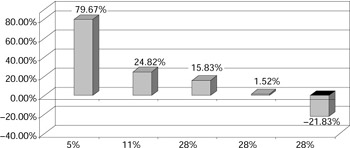Computing Lifetime Value
|
Until 10 years ago, few companies used their databases to compute customer lifetime value. Banks began the process. They were able to determine the profitability of every account on a monthly basis, and to roll that up to compute household profitability. The results were used to segment customers in order to learn which ones were useful to the bank and which ones were reducing the bank’s profits.
I like to use the chart shown in Figure 1-1. It comes from a major bank in the South that ranked all its customers by profitability. It shows that 80 percent of the bank’s profits came from the top 5 percent of its customers. The bottom 28 percent lost 22 percent of its profits. This is very powerful information that was just not available before database marketing came along. What was even more powerful was what the bank was able to do with this information. Clearly the top 5 percent of customers had to be retained. The bank’s whole future rested on these people. In addition, something had to change in the bank’s marketing strategy for the bottom 28 percent. Why try to retain people who are costing the bank money?

Figure 1-1: Profits by Customer Segment
Not just banks, but insurance companies, business-to-business marketers, and scores of other enterprises began to compute numbers like these and to develop strategies that made profitable use of them. Many companies went on to determine potential lifetime value by using computer models to determine all the other products that each customer was likely to buy from the company in the future. Each such product had three attributes:
-
The potential profitability to the enterprise if the customer were to buy the product (based on the customer’s assets and income)
-
The probability that the customer would buy the product if it were offered (based on the purchases of other customers with similar lifestyles)
-
The cost to the company of selling the customer the additional product
From this analysis came the determination of the “next best product” for each customer (in terms of profit to the enterprise and likelihood of response). This product was identified in every customer’s database record and shown on the screens used by all personnel who had customer contact. This has proved to be a highly successful and significant use of database marketing.
|
EAN: 2147483647
Pages: 226